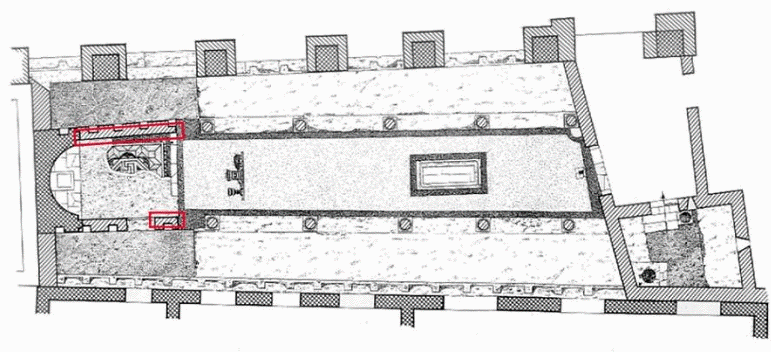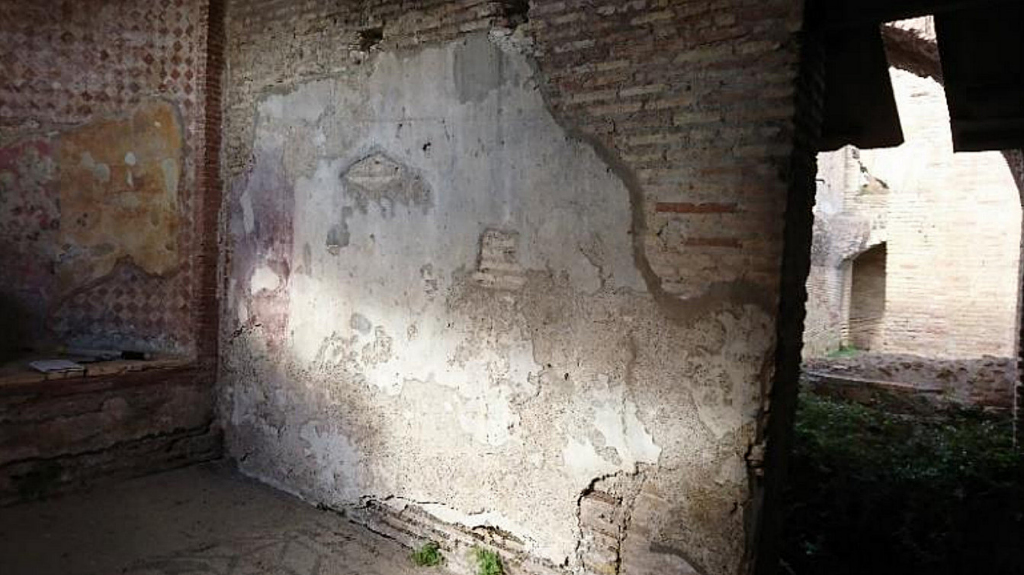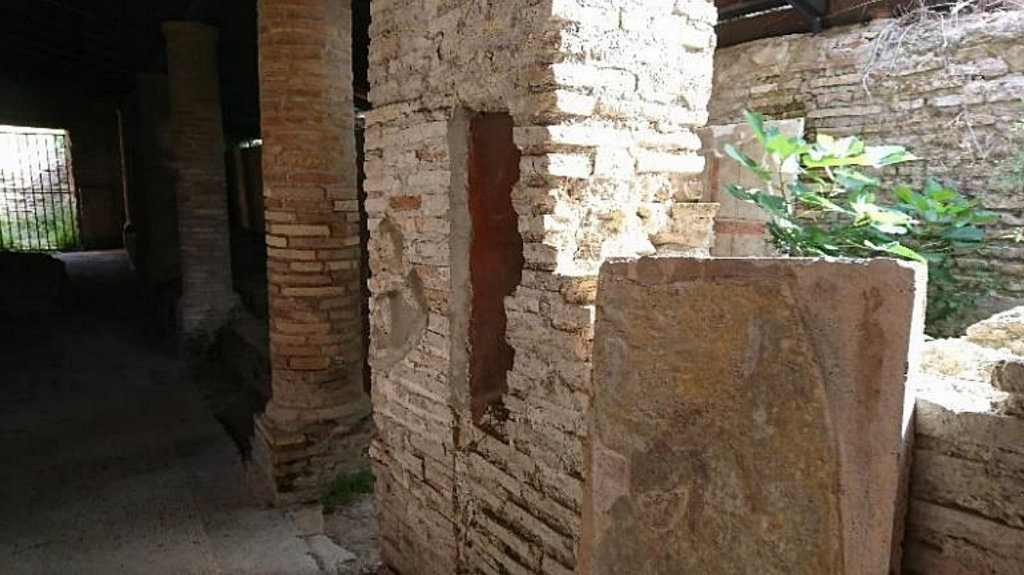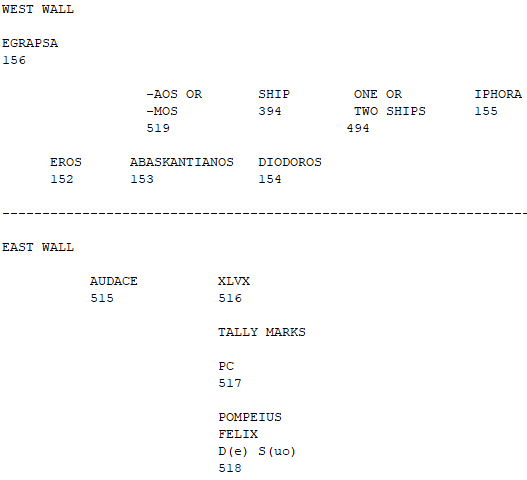The shrine was inspected by Della Corte and Ciprotti, later - in 1967 - by Solin, then - in October 2015 - by Bakker, Brenders and Schmitt, and finally - in 2018 - by Okuyama, Gale and Toyota. There are two groups of graffiti, both in the apsidal cella in the back part of the shrine.
- One is on the plaster of the long west wall. The graffiti are not in the apse itself, but on the secondary wall in front. They are at an average height of 1.40 m from the floor.
- The other group is on the long east wall. The graffiti are not on the face of the wall however. In the front part of this wall, so on the left for those facing the wall, is a blocked passage. Part of this blocking has been removed, in modern times it seems. The graffiti are on the red plaster of the inside of the passage, on the northern, left jamb. In other words, the graffiti could in antiquity no longer be seen when the passage had been blocked.
 |
| West is up. Plan of the shrine with indication of the walls with the graffiti (Okuyama et al. 2018, fig. 14). |

Photo of the west wall, looking towards the apse (Okuyama et al. 2018, fig. 15).

Photo of the east wall, looking away from the apse.
The graffiti are on the red plaster in the centre (Okuyama et al. 2018, fig. 16).
 |
| Sketch of the position of the graffiti, as seen in 2015, and deduced from the publications (Jan Theo Bakker). |
G0152 - EROS
- Not seen in 2015. West wall of apsidal cella.
- Della Corte - Ciprotti 1961, 331, nr. 30. ERΩC was read.
- Solin 2008, 121, nr. 17, fig. 28. Solin saw the graffito to the left of G0153 (Abaskantianos), but almost completely lost, reading only the omege and sigma. Meas. cm 0,8 x 1,4.
- SEG 58, 1088.
Interpretation: Greek text, Eros.
- Della Corte - Ciprotti
- Solin 2008
G0153 - ABASKANTIANOS
- West wall of apsidal cella. To the left of G0154. in 2015 was read: [.]ΒΑCΚΑΝΤΙ[.]ΝΟC.
- Della Corte - Ciprotti 1961, 331, nr. 32: failed to read properly.
- Solin 1972, 197: G0153 (Abaskantianos) and G0154 (Diodoros) are by the same hand; he proposes two different names.
- Solin 2008, 121, nr. 18: meas. of G0153 and G0154 taken together 91 x 2 - 7 cm.
- SEG 58, 1089.
Interpretation: a Greek name, Abaskantianos.
- ICCD N005259 (bottom left)
- ICCD N005260
(bottom)
- ICCD N005296 (bottom left)
- Solin 1972
- Brenders 2015
G0154 - DIODOROS
- West wall of apsidal cella. To the right of G0153. In 2015 was read:ΔΙΟΔΩΡ[--].
- Della Corte - Ciprotti 1961, 331, nr. 32: failed to read properly.
- Solin 1972, 197: G0153 (Abaskantianos) and G0154 (Diodoros) are by the same hand; he proposes two different names.
- Solin 2008, 121, nr. 18: meas. of G0153 and G0154 taken together: 91 x 2 - 7 cm.
- SEG 58, 1089.
Interpretation: a Greek name, Diodoros.
- ICCD N005259 (bottom right)
- ICCD N005296 (bottom right)
- Solin 1972
- Brenders 2015
G0155 - IPHORA
- West wall of apsidal cella. To the right of G0494.
- Della Corte - Ciprotti 1961, 331, nr. 33.
- Solin 2008, 121, nr. 19, fig. 29: meas. 15 x 4 - 8 cm: ΦOPA. The rho is not entirely certain.
- SEG 58, 1090.
- Okuyama et al. 2018, 7, nr. 4, fig. 2: so far the four last letters were recognized, but Okuyama sees an I before the phi, which may indeed be there: IΦOPA. He then suggests a name such as ΘEIΣIΦOPA, but no more letters can be seen on the plaster to the left or above.
Interpretation: Greek text, iphora. Phora is a good Greek word, but has no obvious meaning in this context.
- Della Corte - Ciprotti
- Solin 2008
- Animation, Eric Taylor
- Brenders 2015
- Okuyama et al. 2018
G0156 - EGRAPSA
- West wall of apsidal cella. Not seen in 2015. Above and to the left of G0519.
- Solin 1972, 196 note 3.
- Solin 2008, 119, nr. 12: meas. 5 x 1 - 1,3 cm: EΓPAΨA. Solin gives two variants, without comment: egrapssa and epgrapsa (psi + sigma and psi). Approximately 12 letters are missing at the start (5 cm). The name of a person may have been here. The word may also belong to the hexametric phrase "many wrote much [on the wall], only I did not write", found elsewhere in Ostia.
- SEG 58, 1087.
Interpretation: Greek text, egrapsa; someone "wrote ...".
G0394 - SHIP
- West wall of apsidal cella. To the right of G0519, to the left of G0494.
- Langner 2001, nr. 1992, cf. 2112, 2251, with drawing: "in einer Höhe von 1,40 m".
- Solin 2008, 121, nr. 14, fig. 26: meas. cm 32 x 31. "Nave e vela. Scafo arrondotato, sensibilmente simmetrico, le cui estremità terminano con un motivo triangolare. Nella poppa (a sinistra) sono raffigurati una cabina e i due timoni laterali. Un albero centrale, unico, porta una grande vela quadra che finisce con un pennone sospeso da balanzuole (4 pari). Solo la palmetta che orna l'estremità del pennone è conservata. Delle piccole funi (mattafioni), che servono ad attaccare la vela una volta ripiegata, pendono lungo il pennone. I tratti obliqui, che scendono simmetricamente dall'albero, suggeriscono le sartie e gli stragli che le mantengono".
- Becatti, SO II, 73: suggests on the basis of the graffiti of three ships and the Greek name Diodoros that the Sacello was a meeting place of a guild of shippers or shipowners, practicing the cult of Dionysus.
Interpretation: a cargo ship going to the right.
- ICCD N005259
- ICCD N005296
- Langer nr. 1992
- Brenders 2015
G0494 - ONE OR TWO SHIPS
- West wall of apsidal cella. To the right of G0394.
- Solin 2008, 121, nrs. 15-16, fig. 27: meas. cm 83 x 42. "Nr. 15. Nave con remi e vela. La forma della carena di questa nave è insolita. La parte posteriore (a destra), identificabile grazie alla presenza di un piccolo timone laterale, sembra molto meno elevata della prua, di cui solo il tratto superiore fortemente incurvato verso l'alto è discernibile. Lungo lo scafo, dei tratti obliqui che suggeriscono la presenza di remi. Un unico albero al centro porta una grande vela quadra. Nr. 16. Sotto 15. Piccola imbarcazione alberata (?). Questa è forse la terza nave ricordata da Becatti, che ha visto tutte e tre le navi".
- Becatti, SO II, 73: suggests on the basis of the graffiti of three ships and the Greek name Diodoros that the Sacello was a meeting place of a guild of shippers or shipowners, practicing the cult of Dionysus.
Interpretation: a ship or two ships above each other.
- ICCD N005295
- Brenders fiche4bis.jpg
- Brenders fiche5bis.jpg (detail)
G0515 - AUDACE
- Vague traces seen in 2015. East wall of apsidal cella. To the left of G0516.
- Solin 2008, 119, nr. 8: meas. 10 x 1,5 - 2 cm: [---] AVDACE. The first letter is preserved partially. It looks like a C or and R, but must be an A to make sense of the word. Perhaps the name Audax (dative written as -e, accusative without m, or ablative), or the adjective.
Interpretation: the name Audax, or the adjective audax.
G0516 - XLVX or X LUX
- East wall of apsidal cella. Above G0517.
- Solin 2008, 119, nr. 9: meas. cm 7 x 2 - 3: XLVX. Solin notes that VX does not belong to the Roman numerical system (a few examples are known from Africa), and considers that we may have to read X lux.
Interpretation: a number, or the number X and the word lux.
G0517 - PC AND TALLY MARKS
- East wall of apsidal cella. Above G0518.
- Solin 2008, 119, nr. 10: meas. cm 2,5 - 2: PC. Mentions PC only, but higher up is a long row of tally marks.
- Okuyama et al. 2018, 15, nr. 2: meas. of tally marks 9,4 x 1,5 cm.
Interpretation: PC; in Christian funerary inscriptions PC stands for PACE.
- Brenders 2015
- Okuyama et al. 2018 (tally marks)
- Okuyama et al. 2018 (tally marks, drawing)
G0518 - POMPEIUS FELIX D(e) S(uo)
- East wall of apsidal cella. Below 517. Three lines: POMPEIVS | FIILIX | D(e) S(uo).
- Solin 2008, 119, nr. 11, first two lines only: meas. cm 14 x 7, height of letters 1,5 - 4: POMPEIVS | FIILIX. Solin notes the two different E's: POMPEIVS FIILIX. He does not mention the third line.
Interpretation: the Latin name Pompeius Felix, followed by d(e) s(uo), with d(ono) d(edit) to be added.
G0519 - -AOS or -MOS
- Not seen in 2015. West wall of apsidal cella. Above 153.
- Solin 2008, 119, 121, nr. 13, fig. 25: meas. 4 x 1,5 - 2 cm: -AOS or -MOS.
Interpretation: Greek text, perhaps a Greek name ending on aos or mos.
- ICCD N005259 (far left)
- ICCD N005260 (centre)
- Solin 2008